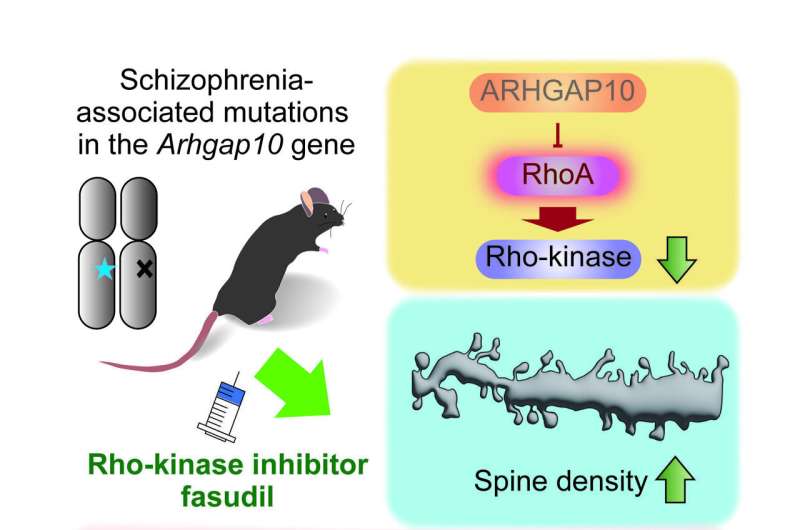This article has been reviewed according to Science X's editorial process and policies. Editors have highlighted the following attributes while ensuring the content's credibility:
fact-checked
trusted source
proofread
Vasodilator drug used in stroke patients found to reverse key symptoms of schizophrenia in mice

A team from Nagoya University in Japan used the drug fasudil to reverse two common symptoms associated with schizophrenia: reduced density of pyramidal neurons and cognitive dysfunction associated with methamphetamine treatment. Their findings, which were published in Pharmacological Research, suggest new therapeutic approaches for treating schizophrenia patients.
Genetic vulnerability is generally accepted to be involved in the development of schizophrenia. One of the key genetic factors involved is copy-number variation, a genetic trait in which people have different numbers of a particular gene. In particular, variations in the copy number of the ARHGAP10 gene are associated with symptoms of schizophrenia.
ARHGAP10 encodes a protein that is involved in the regulation of the Rho GTPase family of enzymes. Among these Rho GTPase family members, a few reports have implicated RhoA in schizophrenia. In the current research, the group theorized that some of the downstream factors of RhoA may be treatment targets. They identified Rho-associated kinase (ROCK), as a potential therapeutic target, since activation of the RhoA/ROCK signaling pathway stimulates many risk factors for schizophrenia.
When model mice with mutations in their ARHGAP10 gene are bred, they exhibit symptoms similar to those of human schizophrenia patients. Symptoms include altered spine density, methamphetamine-induced cognitive dysfunction, and activation of RhoA/ROCK signaling.
"ROCK signaling promotes spine shrinkage and destabilization," said lead researcher Rinako Tanaka from Nagoya University Graduate School of Medicine. "This is important because cognitive impairment, such as that seen in schizophrenia, is known to be associated with spine morphology."
A team led by the Nagoya University Graduate School of Medicine, in collaboration with Fujita Health University, used fasudil to inhibit ROCK in model mice with mutations in their ARHGAP10 gene to see if this improved symptoms. They found that treatment restored the density of pyramidal neurons in the medial prefrontal cortex, a part of the brain associated with attention and long-term memory. As a result, mice with methamphetamine-induced cognitive impairment treated with the drug also performed better on visual discrimination tests.
"Our findings clarify how ROCK contributes to the neuropathological changes in spine morphology and to the cognitive vulnerability to methamphetamine caused by schizophrenia-associated mutations in the ARHGAP10 gene," Tanaka said. "Targeting Rho-kinase signaling may provide new therapeutic approaches for the treatment of schizophrenia patients, including those with ARHGAP10 gene mutations. Inhibitors of Rho kinase, such as fasudil, or those downstream of Rho kinase may be future therapeutic drugs for schizophrenia."
More information: Rinako Tanaka et al, Inhibition of Rho-kinase ameliorates decreased spine density in the medial prefrontal cortex and methamphetamine-induced cognitive dysfunction in mice carrying schizophrenia-associated mutations of the Arhgap10 gene, Pharmacological Research (2022). DOI: 10.1016/j.phrs.2022.106589


















